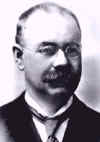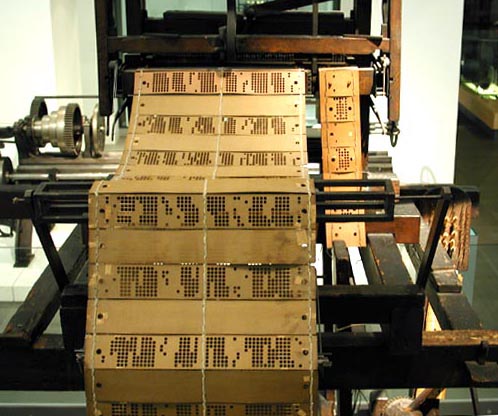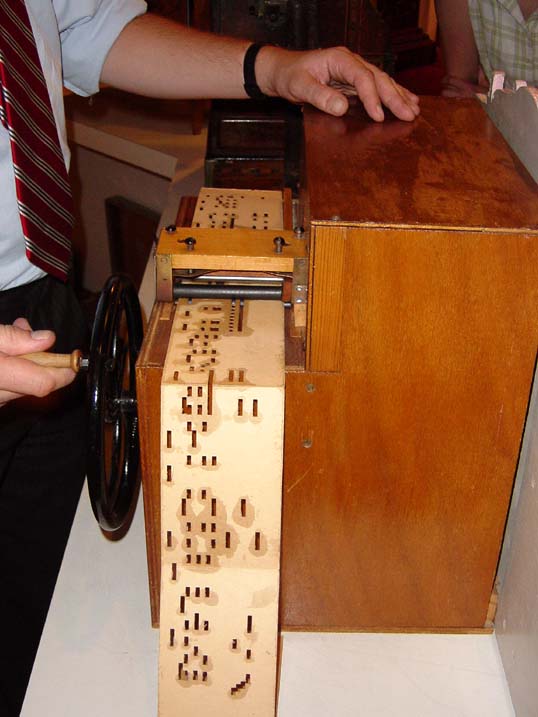From Carillon to IBM
The musical roots of information technology
1. The development of the punched card
The dominant position IBM had in the early computer
business, goes back to the inventions made by a son of German immigrants, Herman Hollerith, who developed
the punched card for the American census of 1890 and who founded
one of the companies that was in 1924 merged with others into IBM,  the Tabulating Machine Company (1896).
Less well-known, but generally recognized in books about the history
of computation, is that Hollerith’s idea was derived
from the punched cards used in the weaving industry since the 1700s.
According to the usual Hollerith lore, the idea was suggested to
Hollerith by his future father-in-law, known to him via
the Census Bureau, Dr John Shaw Billings. Furthermore,
Hollerith’s brother-in-law was allegedly working in the weaving
industry.
the Tabulating Machine Company (1896).
Less well-known, but generally recognized in books about the history
of computation, is that Hollerith’s idea was derived
from the punched cards used in the weaving industry since the 1700s.
According to the usual Hollerith lore, the idea was suggested to
Hollerith by his future father-in-law, known to him via
the Census Bureau, Dr John Shaw Billings. Furthermore,
Hollerith’s brother-in-law was allegedly working in the weaving
industry.
Actually, Hollerith was not the first who proposed punched cards for calculations. In the mid-19th century, the well-known British pioneer of mechanical computers, Charles Babbage, had already suggested the use of punched cards as input media for his impressive machines. Babbage explicitly acknowledged the origin of the idea in the weaving industry. Hollerith could take advantage of the more advanced technology of his days by using electric current rather than mechanical means to read the patterns stored in the cards.
In the 18th century, the silk weaving industry in the Lyon area of France had to cope with stiff British competition and in order to meet the challenge, several methods were developed to automate the weaving of complex patterns. This culminated in the so-called Jacquard loom, after the French inventor, Joseph-Marie Jacquard (born in Lyons, France in 1752, into a family of weavers). Jacquard’s system to program looms (first presented in 1801) was very successful and by 1812, there were already 11,000 Jacquard looms in use in France. Naturally, the ever ambitious British took over the system, giving their textile industry a tremendous boost. By 1833, there were about 100,000 power-looms in Britain applying Jacquard’s idea. The first Jacquard loom in the United States was, to the best of my knowledge, imported by William H. Horstmann of Philadelphia in 1825 (see Eric Broudy, The Book of Looms: A History of the Handloom from Ancient Times to the Present. Brown University Press, 1993).
Here is a picture of such a programmable Jacquard loom (photograph by George P. Landow):

As to the working of a Jacquard loom, I can only cite what others have said before (Paul E. Dunne):
The key idea behind Jacquard's loom was to control the action of the weaving process by interfacing the behaviour of the loom to an encoding of the pattern to be reproduced. In order to do this Jacquard arranged for the pattern to be depicted as a groups of holes `punched' into a sequence of pasteboard card. Each card contained the same number of rows and columns, the presence or absence of a hole was detected mechanically and used to determine the actions of the loom. By combining a `tape' of cards together the Jacquard loom was able to weave (and reproduce) patterns of great complexity, e.g. a surviving example is a black and white silk portrait of Jacquard woven under the control of a 10,000 card `program'.
Punched cards were in common use in computers until the 1980s and few of us realized at the time that the idea of storing information in cards with holes was an example of the successful transplantation of a century-old practice from the French weaving industry. As I will relate in a minute, the basic invention was made as early as around 1725. What is even more surprising is that this invention itself was a successful transfer of ideas used in the programming of music automata since the late Middles Ages!
I will now briefly discuss some aspects of historical
music automata, mainly using pictures I recently took in continental
Europe’s most comprehensive museum about mechanical music, the
Dutch National Museum Van Speelklok tot Pierement in Utrecht (henceforth the Utrecht museum). Street organs, known in every major Dutch town, use books with
punched holes: 
Until the 1890s, street organs had their music programs stored on cylinders with pins, of the kind everyone knows from musical boxes. Cylinders were expensive to make and could store only a limited amount of melodies of limited duration. It is therefore surprising that the much more versatile and cheap organ books came into common use as late as in the 1890s. The use of punched cards for mechanical musical instruments was already patented in 1843 in Lyon by Claude-Félix Seytre, but the first significant “book organ” was built by the Italian Anselmo Gavioli in 1892.
A book organ's mechanism for reading and "processing" is completely mechanical and pneumatic. It does not rely on electrical current, as with Hollerith’s pre-IBM tabulating machines, which were developed at roughly the same time. The pages of the book are mechanically moved over a row of keys, which are kept down by the surface of the pages, but which move up as soon as a punched hole in the book passes. The keys are connected to intricate pneumatic mechanisms to open (or close) an organ pipe (or to initiate some other instrument), so that, in fact, the punched holes in the book regulate the onset and durations of the various musical tones available on the organ.
Interestingly, it is uncontroversial that, exacly as in Hollerith’s case, the idea of programming with punched paper was derived from the weaving industry, particularly from -again- the Jacquard loom. For about 185 years, punched paper was used to program weaving looms and not for automatic musical instruments, for which the advantages turned out to be so obvious.